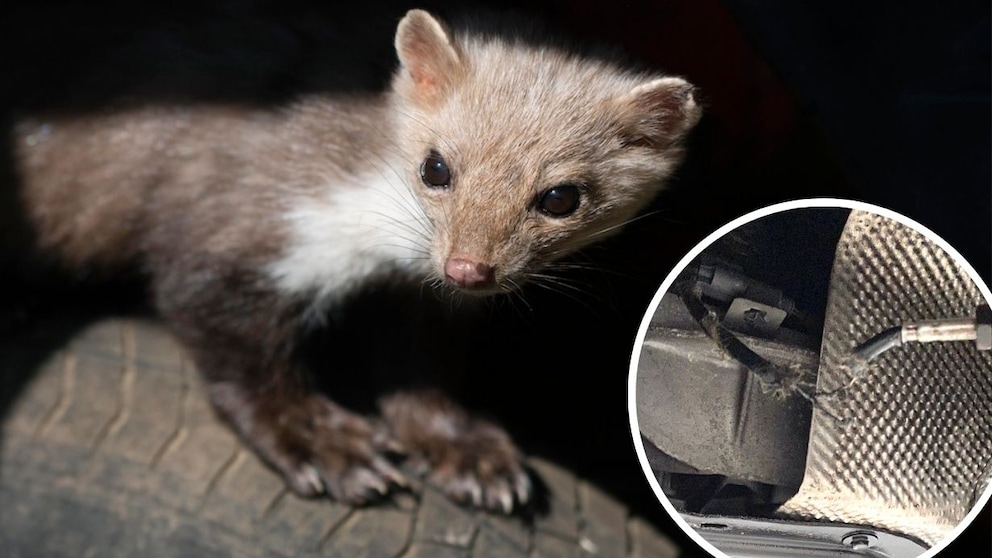September 26, 2024, 9:38 am | Read time: 4 minutes
Over 200,000 cases of car damage caused by martens are reported every year in Germany alone. But what fascinates the animals so much about cables? PETBOOK investigated.
Even people who don’t own a car usually know that martens can cause severe damage to the engine compartment. Every year, over 200,000 cases of marten damage to motor vehicles are reported in Germany.1 With over 66 million cars registered in the country, this is comparatively low. However, according to insurers, the financial damage amounts to over 100 million euros a year!2 But why do martens like to bite car cables so much? Do the animals want to build a nest, or are they just curious?
Why martens like to climb into the engine compartment
Many people think that marten damage could be on the decline as the animal’s natural habitat continues to shrink. But this is not the case. Like foxes, martens have almost completely lost their fear of human dwellings and vehicles. As a cultural successor, we, therefore, find them more and more often in attics, garages, and even in cars.3
But do martens bite car cables in engine compartments in particular? In fact, martens love narrow crevices and caves into which they can squeeze to seek shelter. Therefore, the ambiance in the engine compartment is exactly what the animals want. What’s more, it is still warm in winter when the car has just been parked.
The reason why martens bite cables in cars
It used to be thought that the smell of the warm rubber parts in the car would attract the martens, and they would nibble at the cables for fun. After all, we know this from other animals, too. Anyone who has ever kept rats or rabbits knows that no cable is safe from their sharp little teeth.
In fact, martens biting cables in cars is not about fun or exploratory behavior. The nibbling is related to the animals’ social behavior. If you look at the times when marten damage is reported, you will notice this is usually between June and August. These are precisely the months when the animals mate.
Only the second marten becomes a problem
Martens are solitary animals and defend their territories to the death, especially during the mating season. When two rivals meet, there are often fierce fights. This is why martens mark their territory with a foul-smelling secretion that they produce in their anal glands. It is primarily used to ward off other martens.
Everything in the territory that the marten considers valuable is marked. This also includes the cozy den in the engine compartment. Therefore, it is not the first marten that bites the cables. Instead, the problem only arises when a second animal encounters these markings. As we often move our cars and they are not always parked in a fixed place, several martens will likely visit the engine compartment. If a marten smells a stranger or, rather, its scent marks, it becomes so furious that it bites around and then marks the space with its own scent. The cables and hoses in the engine compartment are particularly affected by the animals’ “rage.” 4
Do all martens cause damage to the car?
In biology, martens refer to a family of dog-like predators (Canoidea), but when we talk about martens, we mean the true martens (Martes), which include the stone and pine marten. However, only the stone marten causes damage to cars. While the pine marten lives mainly in forests, the stone marten is quite adaptable and flexible when it comes to its choice of habitat. This means they can also live in cities.5

Species-appropriate housing Tips for letting rabbits move freely within the home

Penetrating Odors How to Remove Cat Urine Correctly

Behavior Explained Why Dogs Are So Interested in Discarded Christmas Trees
How to protect your car from marten damage
As marten damage only occurs when an animal has already left scent marks, it is important to remove them as thoroughly as possible. This is the only way to ensure that the unwanted visitors do not return, as the animals smell the foreign scent marks in their territory and want to destroy them.
Several household remedies, including dog hair, garlic, or even toilet stones, are said to repel or scare away martens. However, the animals quickly become accustomed to these smells. Experts, therefore, recommend a professional marten repellent for your car. These are available for retrofitting a car from specialist dealers in various versions. These are usually special grilles that reliably keep martens out. Corrugated pipes made of hard plastic are also recommended to protect cables and hoses in the car from the martens’ sharp teeth.6

